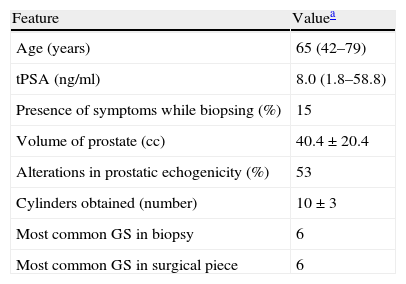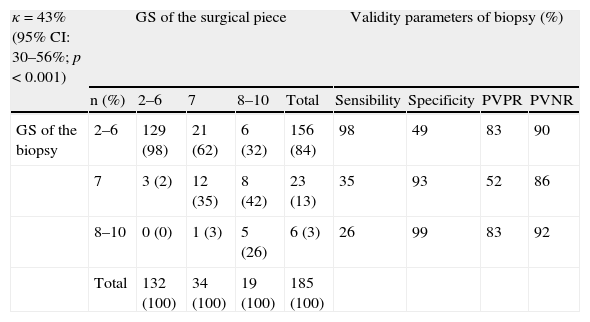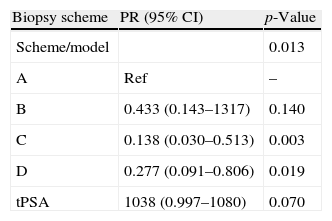To identify factors that might explain why a prostate with a Gleason score (GS) <7 in the biopsy specimen can turn out to have a GS ≥7 in the surgical specimen.
Material and methodsWe compared the GS of biopsy specimens with the GS of surgical specimens in 185 patients who underwent surgery for prostate cancer. We calculated the sensitivity, specificity, and predictive values for the GS of the biopsy specimens. We used Cohen's kappa to determine the degree of concordance between a GS of <7 and ≥7 for the biopsy specimen and the surgical specimen. Age, a family history of prostate cancer, total prostate-specific antigen (tPSA), digital rectal examination, prostate structure and volume, and the number of biopsy cores (biopsy scheme) were analyzed using multivariable logistic regression.
ResultsHistological study of biopsy specimens yielded high sensitivity (98%) but low specificity (49%) for GS ≤6 and low sensitivity (35, 26%) and high specificity (93, 99%) for GS=7 and GS ≥7, respectively. Cohen's kappa for the GS from the biopsy and surgical specimens was 0.43 (95% CI=30–56%). The biopsy scheme was the only predictor of discordance in the GS between the two techniques. Among the other variables included in the model, only tPSA showed a slightly significant association. Taking a scheme with less than 7 cores as a reference, we found no difference with 8 to 9 cores but we did find a difference with 10 to 11 cores and with 12 or more cores, with a prevalence ratio of 0.138 (95% CI=0.030–0.513) and 0.277 (95% CI=0.091–0.806), respectively.
ConclusionThe GS of the biopsy depends on the scheme. This factor must be taken into account when choosing a treatment option in patients with low tumor grade in biopsy specimens.
Identificar los factores por los que un sumatorio de Gleason (SG)<7 en la biopsia pase a ser ≥7 en la pieza quirúrgica.
Material y métodosSe estudiaron 185 pacientes operados por cáncer de próstata comparando el SG de las biopsias con el de las piezas quirúrgicas. Se calcularon la sensibilidad, especificidad y los valores predictivos del SG de la biopsia. La concordancia de la biopsia y la intervención quirúrgica para establecer SG<7 y ≥7 fue estimada con el estadístico Kappa de Cohen. Se analizaron la edad, los antecedentes familiares de cáncer prostático, el antígeno prostático específico total (PSAt), el tacto transrectal, la estructura y el volumen prostáticos, y el número de cilindros de la biopsia (esquema de biopsia) utilizando una regresión logística multivariante.
ResultadosLa biopsia tuvo una alta sensibilidad (98%) y una baja especificidad (49%) para los SG≤6; y una baja sensibilidad (35, 26%) y una alta especificidad (93, 99%) para los SG de 7 y ≥7, respectivamente. El índice Kappa de los SG fue de 0,43 (IC del 95%: 30-56%). El esquema de biopsia fue el único predictor del desacuerdo. Del resto de variables, solo el PSAt mostró una asociación significativa discreta. Tomando como referencia el esquema con <7 cilindros, no hallamos diferencia con 8-9 cilindros, pero sí con 10-11, y ≥12 cilindros, con una razón de prevalencia de 0,138 (IC 95%: 0,030-0,513) y de 0,277 (IC 95%: 0,091-0,806), respectivamente.
ConclusiónEl SG de la biopsia depende del esquema. Este factor tiene que ser considerado a la hora de elegir una opción terapéutica en aquellos pacientes con un grado tumoral bajo en la biopsia.










